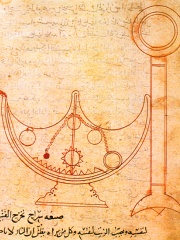
The Most Famous
ENGINEERS from Iraq
Top 1
The following people are considered by Pantheon to be the most legendary Iraqi Engineers of all time. This list of famous Iraqi Engineers is sorted by HPI (Historical Popularity Index), a metric that aggregates information on a biography's online popularity.

1. Banū Mūsā (900 - 873)
With an HPI of 71.09, Banū Mūsā is the most famous Iraqi Engineer. His biography has been translated into 31 different languages on wikipedia.
The Banū Mūsā, literally The Sons of Moses, refers to a Persian family of polymaths, astronomers, mathematicians, and engineers active in 9th century Baghdad. Both their own contributions and their direct connections to other prominent scholars of the House of Wisdom mark them as one of the most preeminent figures of the Islamic Golden Age. The term Banū Mūsā is derived from the name of Mūsā ibn Shākir, and most commonly refers to his three sons; Muḥammad ibn Mūsā (before 803 – February 873); Aḥmad ibn Mūsā (d. 9th century); and Al-Ḥasan ibn Mūsā (d. 9th century). Mūsā ibn Shākir was a renowned astronomer serving directly under the Abbasid caliph al-Ma'mun. After his death, his three sons received an education under al-Ma'mun’s direct orders, and were enrolled at the House of Wisdom in Baghdad. There they undertook the translation of ancient Greek works acquired from Byzantium, which they used to develop their own technological, mathematical and astronomical ideas. They were some of the earliest scholars to adopt Greek mathematics, but innovative in their approach to the concepts of area and circumference by expressing them using numerical values instead of ratios. They made geodesic measurements to determine the length of a degree of latitude, and so obtained a relatively accurate value for the circumference of the Earth. The Banū Mūsā wrote almost 20 books, all but three of which are now lost. The most important of all their works was a treatise on geometry, Kitāb Maʿrifah masāḥat al-ashkāl al-basīṭah wa-al-kuriyyah ("Book on the Measurement of Plane and Spherical Figures"), which was used extensively by medieval mathematicians. Their most famous extant work (of which the oldest and most reliable copy is in the Topkapi Sarayi in Istanbul) is Kitab al-Hiyal al-Naficah ("Book of Ingenious Devices"). It describes 100 inventions, many of which were pouring vessels, intended to entertain party guests. Some of their innovations, such as those that involved fluid pressure variations and valves, remained unsurpassed until the modern period. One of those inventions includes an automatic flute player that may have been the first programmable machine or computer.
People
Pantheon has 1 people classified as Iraqi engineers born between 900 and 900. Of these 1, none of them are still alive today. The most famous deceased Iraqi engineers include Banū Mūsā.

